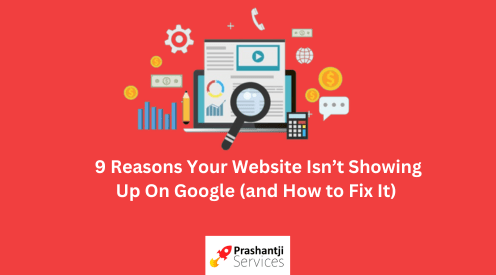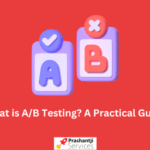In today’s digital landscape, visibility on Google is essential for any website looking to attract visitors and grow its audience. However, many website owners face the frustrating issue of their webpage not available the webpage not appearing in Google search results. This can be a major setback, especially when you’ve put significant effort into building your site. Understanding why your website isn’t showing up on Google and how to fix it is crucial for improving your online presence. In this blog, we’ll explore nine common reasons your site might be hidden from search results and provide actionable solutions to help you get noticed by Google. Whether you’re a seasoned webmaster or just starting, these tips will help you diagnose and resolve visibility issues, ensuring your website reaches its full potential.

1. Website Not Indexed by Google
Your website won’t show up in search results if it isn’t indexed. Google needs to crawl and index your pages to display them to users. This means that if your webpage not available the webpage issue stems from non-indexation, you need to take immediate action.
How to Fix It:
- Create a Sitemap: Use tools like XML Sitemaps or plugins like Yoast SEO (for WordPress) to generate a sitemap.
- Submit to Google Search Console: Go to the Sitemaps section of Google Search Console and submit your sitemap URL.
- Review Robots.txt: Access your robots.txt file and ensure it doesn’t disallow essential parts of your site.
2. Poor Content Quality
Google prioritizes high-quality, relevant content. Thin, duplicate, or low-quality content can prevent your site from ranking well. When users search for why is my google search not working, they expect comprehensive, accurate information.
How to Fix It:
- Create Valuable Content: Focus on creating unique, informative, and engaging content that answers users’ queries. Ensure that your articles, blog posts, and other content pieces are well-researched and well-written.
- Use Long-Tail Keywords: Incorporate long-tail keywords like why is my google search not working, web not available, and google com site naturally in your content. These keywords help attract more specific and targeted traffic.
- Conduct Keyword Research: Use tools like Ahrefs, SEMrush, or Google Keyword Planner to identify relevant long-tail keywords.
3. No Backlinks
Backlinks are essential for SEO. They act as votes of confidence from other websites, signaling to Google that your content is valuable. Without backlinks, your site might struggle to rank.
How to Fix It:
- Build Quality Backlinks: Reach out to relevant websites for guest posting opportunities and create shareable content to attract organic backlinks.
- Internal Linking: Improve your internal linking structure to help Google discover more pages on your site. Internal links also help distribute page authority throughout your site.
- Create Link-Worthy Content: Produce content that is highly valuable and shareable, such as in-depth guides, infographics, and original research.
4. Technical SEO Issues
Technical problems can hinder Google’s ability to crawl and index your site. Issues like broken links, slow site speed, and poor site structure can all contribute to your webpage not available the webpage problem.
How to Fix It:
- Fix Broken Links: Use tools like Screaming Frog or Ahrefs to identify and fix broken links on your site. Broken links can disrupt the user experience and negatively impact SEO.
- Improve Site Speed: Optimize images, leverage browser caching, and minimize JavaScript to enhance your site speed. A faster site improves user experience and can lead to higher rankings.
- Conduct a Technical SEO Audit: Use tools like Google Search Console, Screaming Frog, and SEMrush to perform a comprehensive audit of your site.
5. No Mobile Optimization
When Google utilises mobile-first indexing, it ranks and indexes your website primarily using its mobile version. If your website is not mobile-friendly, it might not rank well in search results.
How to Fix It:
- Responsive Design: Ensure your website is mobile-friendly and provides a good user experience across all devices. A responsive design adjusts to different screen sizes, making it easy to navigate on both desktops and mobile devices.
- Test Your Site: Use Google’s Mobile-Friendly Test to check how easily a visitor can use your page on a mobile device. The test will provide insights into issues that need fixing.
- Mobile-Friendly Test: Run your site through Google’s Mobile-Friendly Test and address any issues it identifies.
6. Keyword Cannibalization
When multiple pages on your site target the same keyword, they compete against each other, leading to lower rankings. This can weaken your SEO efforts and confuse search engines.
How to Fix It:
- Consolidate Content: Merge similar pages to create comprehensive content that covers the topic thoroughly. This helps to centralize the authority of your content and prevent competition between your own pages.
- Optimize Differently: Use distinct keywords for different pages to avoid cannibalization. Each page should target unique keywords to complement your overall SEO strategy.
- Monitor and Adjust: Regularly check for keyword cannibalization and adjust your content strategy accordingly to maintain optimal performance.
7. Penalized by Google
Violating Google’s guidelines can result in penalties that significantly impact your rankings. These penalties can be manual or algorithmic and can severely damage your site’s visibility.
How to Fix It:
- Identify Penalties: Use Google Search Console to check for manual actions and review your analytics for sudden drops in traffic that may indicate algorithmic penalties.
- Address Violations: Fix the issues that led to the penalty. This might involve removing harmful backlinks, improving content quality, or correcting technical problems.
- Submit Reconsideration Request: Once all issues are fixed, submit a reconsideration request through Google Search Console, explaining the steps you’ve taken to rectify the violations.
8. Lack of Social Signals
While social signals are not a direct ranking factor, they can influence your SEO indirectly by driving traffic and engagement. A strong social presence can enhance your online visibility and support your SEO efforts.
How to Fix It:
- Build a Social Media Strategy: Develop a plan for regular posting and engagement on platforms like Facebook, Twitter, LinkedIn, and Instagram.
- Create Shareable Content: Produce content that is engaging and easy to share. Use compelling headlines, visuals, and clear calls to action.
- Engage with Your Audience: Respond to comments and messages on social media to build relationships and encourage further sharing.
9. No HTTPS Security
Google gives preference to secure sites. If your site isn’t using HTTPS, it might be penalized in rankings. HTTPS ensures that the data exchanged between the user and your site is encrypted and secure.
How to Fix It:
- Purchase and Install SSL: Buy an SSL certificate from a trusted provider and install it on your server. Via Let’s Encrypt, numerous hosting companies provide free SSL certificates.
- Update Internal Links: Use tools to update all internal links to HTTPS. This includes links in your database, CSS, JavaScript, and other files.
- Set Up Redirects: Implement 301 redirects from HTTP to HTTPS to ensure users and search engines are directed to the secure version of your site.
Conclusion
Addressing these nine issues can significantly improve your website’s visibility on Google. By ensuring your site is indexed, producing high-quality content, building backlinks, fixing technical issues, optimizing for mobile, avoiding keyword cannibalization, adhering to Google’s guidelines, leveraging social signals, and securing your site with HTTPS, you can overcome the challenge of your webpage not available the webpage issue and see better search engine rankings. Implement these strategies to enhance your site’s SEO and attract more visitors.
At Prashantji Services, we specialize in helping businesses like yours improve their online presence through effective SEO strategies. Remember, SEO is an ongoing process. Regularly monitor your site’s performance, stay updated with Google’s algorithm changes, and continuously optimize your content to maintain and improve your rankings.








